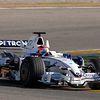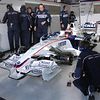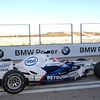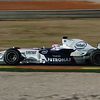F1.08 uncovered (+pics)

The BMW Sauber F1 Team has unveiled their 2008 contender today at BMW Welt in Munich. The F1.08 is discribed as a completely different car than the F1.07 and when you take a first look at the car, the new front wing and winglets immediately catch your eye.
The BMW Sauber F1.08 has been built on high-class foundations, its predecessor – the F1.07 – having comfortably lived up to everything expected of it. The designers, therefore, enjoyed a sound basis on which to build, and were under no pressure to take any major risks. “That’s why we decided to go for evolution rather than revolution,” says Technical Director Willy Rampf. Added to which, the engineers benefited from the achievement of the BMW Sauber F1 Team in establishing itself as the third-strongest team on the grid early on in 2007. “That gave us the chance to divert more resources to the development of the new car,” explains Rampf. “We put our faith in some logically consistent approaches, which led to interesting solutions.” The result is a car which Rampf describes as a “radical evolution”.
“Our aim was to build a car with impressive aerodynamic efficiency, but which also boasted a very stable aero balance. Which means that it hardly loses any downforce when the wheels are turned in, and thus gives the driver a lot of confidence,” says Rampf, offering a glimpse into his team’s thinking. Two other items on the priority list were an improvement in mechanical grip – in order to fully exploit the potential of the tyres – and a reduction in the weight of numerous components. This approach was designed to allow a high level of flexibility in terms of weight distribution through the maximum use of ballast. There was, however, no room for compromise as far as rigidity was concerned. The F1 regulations inevitably play a central role in the construction of a new car. The two key changes to the rulebook for 2008 were the introduction of a standard electronics unit (SECU) and the new running time stipulation for the gearbox, which is now required to survive four consecutive grands prix.
The development of the chassis was particularly hard hit by the incorporation of the SECU, with the traction control and engine braking control systems among the casualties of the new standard unit. This had the effect of making the car considerably more nervous under acceleration and braking. In order to counteract the loss of traction control as far as possible, the engineers focused particular attention on improving mechanical grip.
The concept phase got underway in May. “The scheduling looked after itself really, as we wanted to evaluate the data from the first few races of the season before getting down to work on the design of the new car,” says Rampf. Among the areas of the car decided on at this point were the position of the engine, the length of the gearbox, the wheelbase, weight distribution, tank size and suspension concept. Here, the experience collected by the technicians with the standard Bridgestone tyre played an important role.
Striking front wing
Look the F1.08 in the eye and its front wing cuts an imposing figure. A totally new development, it now consists of three elements. The BMW Sauber F1 Team’s aerodynamics experts invested a considerable amount of time in its design; after all, the front wing affects the aerodynamics of the whole car. Only if this component possesses extremely high downforce potential will the car be able to show perfect balance.
The nose section of the car, which is significantly slimmer than that of its predecessor, has to work harmoniously with the front wing, as Rampf confirms: “You can’t treat the individual components in isolation. At the end of the day, it is critical that they work together to optimum effect.”
When it came to developing the concept for the side turning vanes, the aerodynamics experts returned to their experience with the F1.07. On the new car these are once again made up of two elements – the forward turning vane and the main turning vane. Although appearing identical to the turning vanes on the 2007 car, when you take a closer look they are actually totally different. The endeavours of the aerodynamics team have ensured improved airflow around the sidepods and enabled the underbody to work with great efficiency.
The sidepods have undergone minor modifications in both form and size in order to further enhance cooling. With the engineers having enjoyed a successful result with the cooling concept of the F1.07, the same principle was retained, and complemented by further optimisation measures, in the development of the F1.08. This paved the way for heavier tapering at the rear of the sidepods, enabling extremely efficient airflow to the rear wing and diffuser. The radiator remains in a similar position as on the F1.07.
Ultra-slim rear
The engine cover has been downsized substantially in terms of bulk, improving the efficiency of the rear end. The cooling air outlets and “chimneys” have been optimised to almost eliminate any tail-off in performance during a GP run in extreme heat. Positioning the exhaust system at particularly close quarters to the engine was a factor in achieving the extremely slim-cut construction of the rear. The new layout was developed in cooperation with engine develop-ment colleagues in Munich, who refined the construction during a series of trials on the test rig.
The extra wing elements on the engine cover – which link up harmoniously with the winglets in front of the rear wheels – are another all-new feature of the 2008 car. These not only generate downforce but also enhance airflow to the rear wing, which is itself a further development of last year’s version.
The car’s aerodynamics are rounded off by the wheel rim covers, fixed stationary on the front axle but designed to turn with the wheels at the rear. Their task is the same at both the front and rear: to optimise brake cooling and improve the flow of air around the tyres. A critical factor in all of these developments was the interplay between the testing programme in the wind tunnel and CFD (computational fluid dynamics). It was late 2006 when the team’s experts put the supercomputer Albert2 into operation. Based on Intel technology, its huge performance potential has allowed the engineers to carry out not only more, but also extremely complex calculations.
The development process for the suspension was still young when the engineers began to address the implications of traction control’s fall from grace. Added to which, they also set about channelling the knowledge gained with the standard Bridgestone tyre in 2007 into the new car. Their aim was to make optimum use of the tyres both on a hot lap in qualifying and over the full race distance. And that meant ensuring a combination of good traction and high braking stability. Achieving this goal would help to preserve the tyres and make life easier for the drivers by providing stable handling. The front suspension is a consistent further development of the system familiar from the F1.07. Modified kinematics and another step forward in the power steering system ensure increased feedback for the driver. The rear-axle kinematics were designed to give the car predictable handling and imbue the driver with plenty of confidence.
Changes to the appearance of the cockpit area can be traced back to new safety stipulations set out in the F1 regulations. The cockpit’s head protection sidewalls had to be raised further to enhance safety for the drivers should their car be hit by another car which is off the ground.
“In the development of the BMW Sauber F1.08 we concentrated our efforts on the two areas which offered most potential in terms of performance: aerodynamics and the chassis, with its knock-on effect on tyres,” says Rampf, and adds: “Our success with the F1.07 gave the whole team a lot of confidence, and that has now been reflected in a number of innovative solutions. The data we are getting from the BMW Sauber F1.08 is very encouraging.”
Pre-season development work still had a long way to run after the presentation of the F1.08 on 14th January 2008 – as Rampf explains: “We will come up with a new aerodynamics package before the first race of the season in Melbourne.” A notable side-effect of this will be a moderately striking change in the outward appearance of the F1.08.
BMW Sauber F1.08 – technical data.
Chassis
Chassis: carbon-fibre monocoque
Suspension: upper and lower wishbones (front and rear), inboard springs and dampers, actuated by pushrods (Sachs Race Engineering)
Brakes: six-piston brake callipers (Brembo), carbon pads and discs (Brembo, Carbone Industrie)
Transmission: 7-speed quick shift gearbox, longitudinally mounted, carbon-fibre clutch (AP)
Chassis electronics: MES
Steering wheel: BMW Sauber F1 Team
Tyres: Bridgestone Potenza
Wheels: OZ
Dimensions: length 4,600 mm
width 1,800 mm
height 1,000 mm
track width, front 1,470 mm
track width, rear 1,410 mm
wheelbase 3,130 mm
Weight: 605 kg (incl. driver, tank empty)
BMW P86/8 – technical data
Type: normally aspirated V8
Bank angle: 90 degrees
Displacement: 2,400 cc
Valves: four per cylinder
Valve train: pneumatic
Engine block: aluminium
Cylinder head: aluminium
Crankshaft: steel
Oil system: dry sump lubrication
Engine management: standard ECU (MES)
Spark plugs: NGK
Pistons: aluminium
Connecting rods: titanium
Dimensions: length 518 mm
width 555 mm
height 595 mm (overall)
Weight: 95 kg
Maximum engine speed: 19,000 rpm








